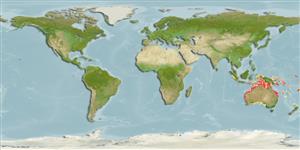>
Atheriniformes (Silversides) >
Atherinidae (Silversides) > Craterocephalinae
Etymology: Craterocephalus: Greek, krater, -eros = bowl, mixing vessel + Greek, kephale = head (Ref. 45335).
Environment: milieu / climate zone / depth range / distribution range
Ekologi
laut; payau dasar (demersal). Tropical
Western Pacific: Abrolhos Islands, Western Australia to Gulf of Carpentaria, Northern Territory, Australia.
Size / Weight / umur
Maturity: Lm ? range ? - ? cm
Max length : 8.5 cm TL jantan/; (Ref. 9760)
deskripsi pendek
Morfologi | Morfometrik
Duri punggung (Keseluruhan (total)): 5 - 7; duri punggung lunak (Keseluruhan (total)): 6-8; Duri dubur 1; Sirip dubur lunak: 7 - 10. Gill rakers short, with spinules, 1-13 on first lower gill arch. Anus very close to origin of fin. Second dorsal fin with I spine, 6-8 rays; anal fin with I spine and 7-10 rays. Midlateral scales 29-33.
Essentially an estuarine species and coastal species, co-occurring with C. pauciradiatus, C. mugiloides and Atherinomorus endrachtensis. Biology not known except that it can withstand very high salinities. Probably taken as food by larger commercial species. (Ref. 9760).
Life cycle and mating behavior
Kematangan | Reproduksi, perkembang biakan | Pemijahan | telur-telur | Fecundity | Larva
Ivantsoff, W. and L.E.L.M. Crowley, 1999. Atherinidae. Silversides (or hardyheads). p. 2113-2139. In K.E. Carpenter and V.H. Niem (eds.) FAO species identification guide for fishery purposes. The living marine resources of the Western Central Pacific. Volume 4. Bony fishes part 2 (Mugilidae to Carangidae). FAO, Rome. (Ref. 9760)
Status IUCN Red List (Ref. 130435)
ancaman kepada manusia
Harmless
penggunaan manusia
Perikanan: tidak ada kepentingan
informasi lanjut
Nama-nama umumSinonim (persamaan)metabolismePemangsaEkotoksikologiReproduksi, perkembang biakanKematanganPemijahanSpawning aggregationFecunditytelur-telurpekembangan telor
Umur / SaizPertumbuhanpanjang-beratpanjang-panjangukuran frekuensiMorfometrikMorfologiLarvaDinamika larvapemulihanKelimpahanBRUVS
AcuanBudidaya airprofil budidaya airStrainGenetikaElectrophoresesDiturunkanPenyakit-penyakitPengolahanNutrientsMass conversion
mitraGambarStamps, Coins Misc.Suara-suaraCiguateraKecepatanTipe renangArea insangOtolithsOtakPenglihatan / visi
Alat, peralatan
laporan khas
muat turun XML
Sumber internet
Estimates based on models
Preferred temperature (Ref.
123201): 21.8 - 28.5, mean 26.9 °C (based on 258 cells).
Phylogenetic diversity index (Ref.
82804): PD
50 = 0.5000 [Uniqueness, from 0.5 = low to 2.0 = high].
Bayesian length-weight: a=0.00389 (0.00180 - 0.00842), b=3.12 (2.94 - 3.30), in cm total length, based on all LWR estimates for this body shape (Ref.
93245).
Trophic level (Ref.
69278): 3.0 ±0.4 se; based on size and trophs of closest relatives
Daya lenting (Ref.
120179): Tinggi, Waktu penggandaan populasi minimum kurang dari 15 bulan (Preliminary K or Fecundity.).
Fishing Vulnerability (Ref.
59153): Low vulnerability (10 of 100).
